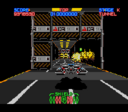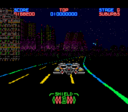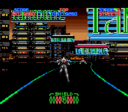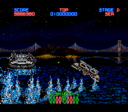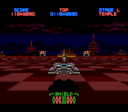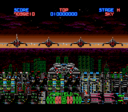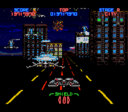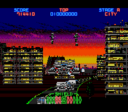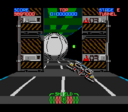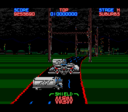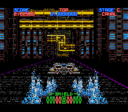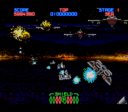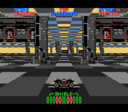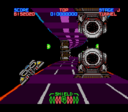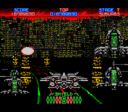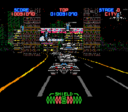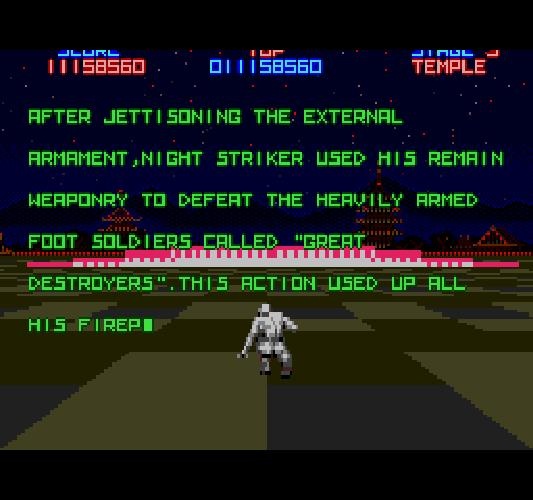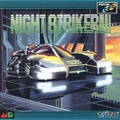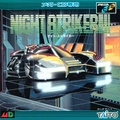Difference between revisions of "Night Striker"
From Sega Retro
(→Physical scans: rm subheading) |
|||
| Line 86: | Line 86: | ||
==Physical scans== | ==Physical scans== | ||
| − | |||
{{ratings|MCD}} | {{ratings|MCD}} | ||
{{Scanbox | {{Scanbox | ||
Revision as of 03:10, 28 May 2023
- For the Sega Saturn game, see Night Striker S.
| Night Striker | |||||||||||||||
|---|---|---|---|---|---|---|---|---|---|---|---|---|---|---|---|
| System(s): Sega Mega-CD | |||||||||||||||
| Publisher: Taito | |||||||||||||||
| Developer: Aisystem Tokyo | |||||||||||||||
| Original system(s): Arcade boards | |||||||||||||||
| Developer(s) of original games: Taito | |||||||||||||||
| Peripherals supported: XE-1 AP | |||||||||||||||
| Genre: Shooting[1] | |||||||||||||||
| Number of players: 1 | |||||||||||||||
| |||||||||||||||
|
Night Striker (ナイトストライカー) is an arcade game developed by Taito. It is a futuristic on-the-rails shooter which plays similarly to Sega's Space Harrier, with the player piloting a hover vehicle.
The game was brought to the Sega Mega-CD in 1993, and this version was brought outside of Japan via the Mega Drive Mini 2 in 2022.
Contents
Story
The game is set in a futuristic city in 2049. A terrorist organisation has kidnapped Doctor Masker Lindberry and his daughter. The United Nations Special Service Agency has dispatched their agents to investigate, but to no avail. Its leader is leading a task force, code-named Night Striker, using armoured vehicles to rescue them and destroy the organisation.
Gameplay
The game is a rail shooter with a 3D perspective. The player controls a hover car and shoots enemies encountered during the stage. The car moves by holding in any direction with the D-Pad. The vertical controls are inverted, so ![]() ascends and
ascends and ![]() dives. The car positions itself back in the center of the screen when the player is not holding a direction. The player does not control the speed at which the car travels through the stages. The car shoots with
dives. The car positions itself back in the center of the screen when the player is not holding a direction. The player does not control the speed at which the car travels through the stages. The car shoots with ![]() ,
, ![]() , or
, or ![]() ;
; ![]() can be held for continuous fire.
can be held for continuous fire.
At the end of each stage, there is a boss. After it is defeated, the player is presented with a choice between two routes, like OutRun. There are 21 stages, but the player only needs to complete 6 to complete the game. Stages repeat themes and bosses. Certain stages contain obstacles such as barriers which must be maneuvered around. In the final stages, the car transforms into different vehicles such as a motorbike or a robot. The game features different endings depending on which route is taken.
The car has a shield that can absorb a certain number of hits before being destroyed. The car is harmed by enemy fire or running into obstacles, but it is not harmed by touching walls or ceilings. The player is given another shield point after completing each stage. If the shield has run out, the car can sustain one more hit before it is destroyed and the game is over. The game can be continued if the player has credits remaining.
Stages
|
Music and sound
The soundtrack was composed by Zuntata, Taito's in-house music team.
Versions
The Mega-CD version of the game takes advantage of the system's specialized sprite-scaling hardware, though it has been criticized for appearing excessively pixelated. This version features an arranged soundtrack; the other home versions only have the original arcade synth soundtrack.
Production credits
- Producer: Yoshio Imamura
- Director: Takashi Shiokawa
- Programmers: Daikoku Hisaya, Yoshihiro Yokota
- Artists: Munenori Morikawa, Satomi Yokose, Yoko Gotan, Shrine
- Sound
- Arranged by: Hisayoshi Ogura, Tamayo Kawamoto, Yasuhisa Watanabe, Shuichiro Nakazawa, Masahiko Takaki
- Mix Engineer: Masao Saotome
- Assistant Engineer: Yoshihiro Rakumitsu
- Manipulated by: Masaki Sekishima
- Special Thanks: Kenshi Kaito, Eiji Takeshima, Anthony Gurr, Yoichi Sato, Pony Canyon Inc., Scytron & Art Inc.
- (C)Taito Corporation 1993 All Rights Reserved
Digital manuals
Magazine articles
- Main article: Night Striker/Magazine articles.
Physical scans
| Sega Retro Average | |||||||||||||||||||||||||||||||||||||||||||||||||||||||||||||||||||||
|---|---|---|---|---|---|---|---|---|---|---|---|---|---|---|---|---|---|---|---|---|---|---|---|---|---|---|---|---|---|---|---|---|---|---|---|---|---|---|---|---|---|---|---|---|---|---|---|---|---|---|---|---|---|---|---|---|---|---|---|---|---|---|---|---|---|---|---|---|---|
|
| 37 | |
|---|---|
| Based on 13 reviews | |
Technical information
- Main article: Night Striker/Technical information.
References
- ↑ 1.0 1.1 https://sega.jp/fb/segahard/mcd/soft_licensee.html (Wayback Machine: 2019-06-10 17:56)
- ↑ File:NightStriker MCD JP SSCredits.pdf
- ↑ Beep! MegaDrive, "June 1993" (JP; 1993-05-08), page 24
- ↑ Dengeki Mega Drive, "June 1993" (JP; 1993-05-xx), page 31
- ↑ Famitsu, "1993-06-04" (JP; 1993-05-21), page 39
- ↑ GameFan, "Volume 1, Issue 7: June 1993" (US; 1993-xx-xx), page 17
- ↑ Game Power, "Settembre 1993" (IT; 1993-0x-xx), page 98
- ↑ Sega Mega Drive Advanced Gaming, "September 1993" (UK; 1993-07-29), page 50
- ↑ Mega, "August 1993" (UK; 1993-07-15), page 52
- ↑ Mega Action, "August 1993" (UK; 1993-07-15), page 32
- ↑ MegaTech, "August 1993" (UK; 1993-07-20), page 76
- ↑ Mean Machines Sega, "September 1993" (UK; 1993-07-30), page 56
- ↑ Sega Power, "September 1993" (UK; 1993-08-05), page 52
- ↑ Sega Pro, "September 1993" (UK; 1993-08-12), page 64
- ↑ Sega Saturn Magazine, "September 1995" (JP; 1995-08-08), page 85
| Night Striker | |
|---|---|
|
Main page | Comparisons | Magazine articles | Reception | Technical information | |


